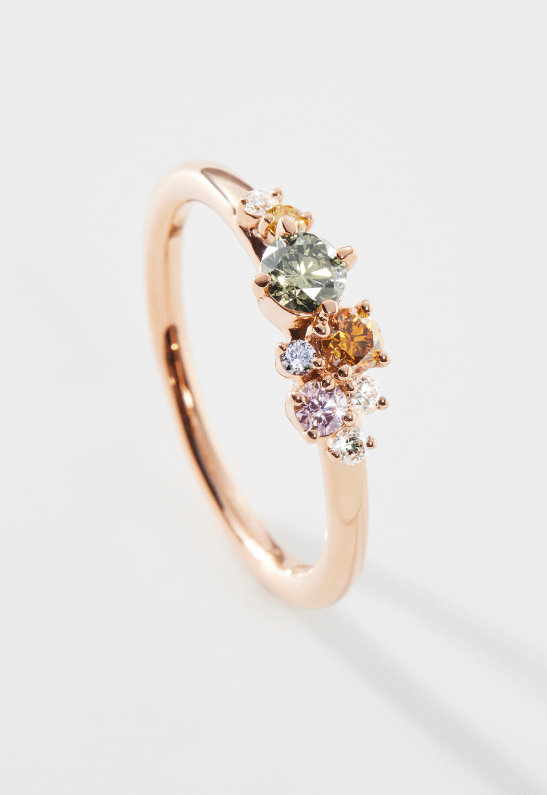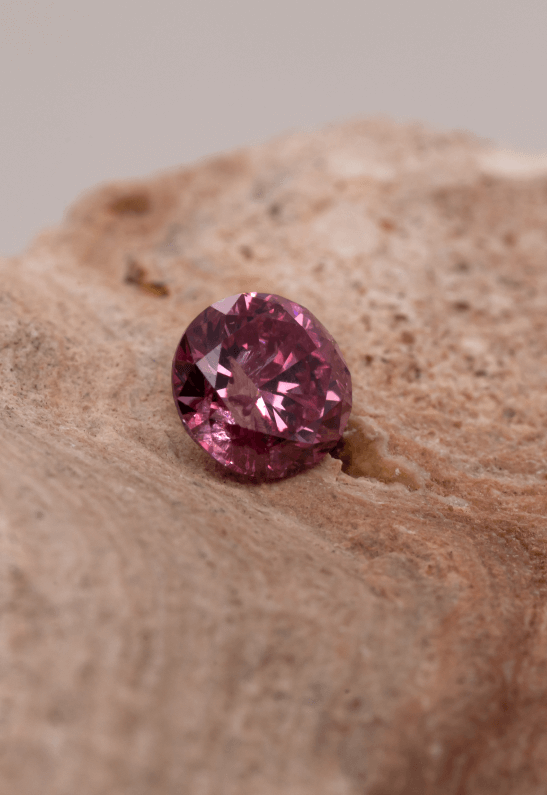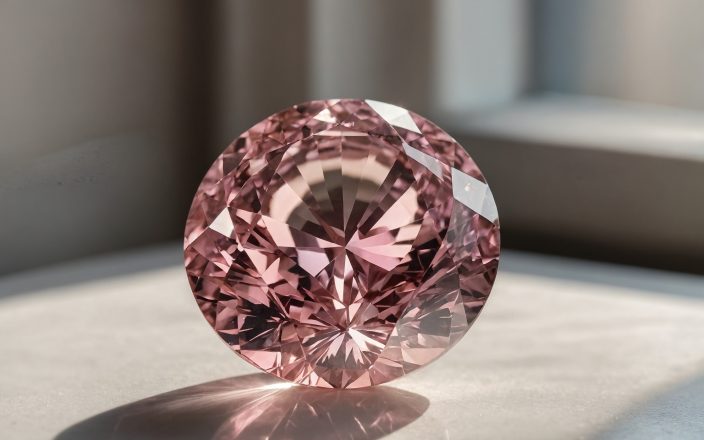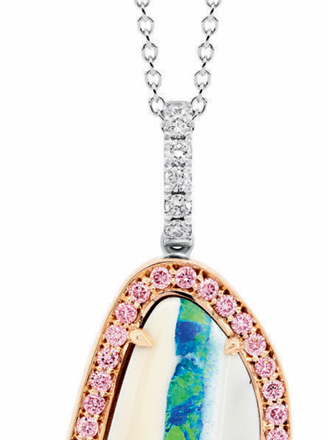
Did you know the average price of all colours and sizes of fancy colour diamonds climbed by 3.9 percent in 2022, according to The Fancy Color Research Foundation? Coloured diamonds have surfaced, not just as precious stones but as treasured works of art. With mesmerising hues and rarity, coloured diamonds capture the fascination of all. As the demand for these gems continues to rise, so does the opportunity for those who understand the nuances of this market.
In the wake of the Argyle mine’s closure, the coloured diamond landscape is evolving, presenting challenges and openings for sellers. The art of selling coloured diamonds can confuse those seeking to get on board. We spoke to coloured diamond experts to learn how to navigate the process.
Colours and Trends
In recent years, the coloured diamond market has experienced an extraordinary surge in popularity, captivating seasoned investors and newcomers to the trade. What makes coloured diamonds particularly enchanting is their exceptional appeal, setting them apart from their colourless counterparts. This growing popularity is due to several factors, including a shift in consumer preferences towards unique and vibrant gemstones. Unlike the traditional choice for colourless diamonds, buyers are more attracted to the rich and varied palette delivered by coloured diamonds.
Offering a range of colours from different regions broadens customer interest. “We boast a vast collection of Australian-origin diamonds in colours like white, pink, red, blue, yellow, and champagne. We also offer diamonds from other origins, like Brazil and Canada. Our inventory includes unconventional cuts, such as the Teddy Bear cut, Elongated Princess French cut, Elongated Pear Drop Rose cut, Baguette Emerald cut, and another geometrical odd cut” he says.says Chris Soklich, director of Ellendale Diamonds.
Ellendale stays atop industry trends by actively nurturing strong partnerships with leading diamond producers, cultivating a continuous exchange of invaluable insights. “Our robust alliances with leading diamond producers facilitate regular intel exchanges. We also maintain open channels with trade partners, fostering a dynamic flow of information, trends, and demands. Our subscriptions to industry publications, including those to Rapnet and Jewellery World, further keep us abreast of the industry pulse,” he adds.
As Michael Neuman, the company director of Mondial Pink Diamond Atelier, aptly puts it, “We have always prized quality in coloured diamonds above all else, and we are constantly looking out for the best combination of fine colours and reasonable prices when purchasing coloured diamonds for our stock collection. Sadly, there’s no magic in the world and usually, the finest colours are only available at a price to match. Our customers range across a very broad spectrum, and we have always found that focusing our attention on quality and value has enabled us to attract clients who appreciate what we do.”
“We don’t follow the trends—we follow our instincts and have always been setting the trends with coloured diamonds in Australia. Pinks, of course, are popular in our store, and it seems that there’s more interest in blue diamonds than ever before. Yellow, champagne, and cognac remain steady,” he adds.
Shivangi Modi, the general manager of product and finance at Nina’s Jewellery, says there’s a clear shift happening in the world of engagement rings. “We are seeing a huge move towards coloured diamond engagement rings… Customers are getting more adventurous and seeking beyond the classic white—personalisation is not going anywhere, and adding a coloured diamond is a great way to achieve a unique look. And, of course, even years after the closure, the interest in Argyle pink and blue diamonds is ongoing.” This evolving trend underscores a growing desire for uniqueness and personal expression, where coloured diamonds are making their mark as a symbol of enduring love.
Regarding market trends and demand for pink diamond colours, Eric Kariuki, the managing director of Kariuki Diamonds, says Argyle pink diamonds are the most in-demand. “We are seeing demand increasing for lighter tones, such as the 5 – 6P, PP, and PR, even though the richer tones are rarer and more valuable. This is typically a demand-driven industry,” he says.
Nina’s Jewellery doesn’t just wait for trends to evolve—the team is constantly searching. “Our diamond buyer and product team [have] specialised in coloured diamonds for decades—it’s their superpower. We go to Surat and Hong Kong once a year or so and pick most of our stones ourselves, so every single stone must convince us before it is ever shown to a customer. It’s a very intense process to get the right, most desirable hues, and in particular, to create matching pairs—because they are so unique. But at the end of the day, regardless of market value or best practice or even our expertise, when it comes to colour, it always comes down to personal preference—the customer has to love the colour,” says Shivangi Modi.
“Personalisation and one-of-a-kind pieces continue to be drivers. Coloured diamonds have added appeal because whilst all natural diamonds are one of a kind, coloured diamonds look it. We’d also love to see the re-emergence of the Australian yellow one day—the world loves Australian diamonds, and so do we,” she adds.
Regarding a focus on pink diamonds, Kariuki clarifies, “We don’t exclusively deal with pink diamonds only, however, we certainly do specialise in investment-grade stones, and pinks are the best performing and have the highest demand, which is why we focus on these diamonds more so than others. As diamond specialists, we were approached by an investor looking to build a portfolio of pink diamonds, so after helping him, more and more clients started coming to us to acquire pink diamonds. Hence why we decided to focus on them to meet the demand.”
Excelling in the coloured diamond market, a profound comprehension of these gemstones and their distinctive attributes is indispensable. Beyond the fundamentals of the 4Cs, in-depth knowledge encompassing factors like origin, colour intensity, and treatments is paramount. Such expertise enables you to recognise the intrinsic beauty of coloured diamonds and empowers you to convey their uniqueness and value convincingly to potential buyers.
Selling Challenges
Navigating the world of selling coloured diamonds presents its unique set of challenges, ones that demand skill and a deep understanding of the intricacies within the market. In this dynamic landscape, where every stone tells a story, successfully addressing these challenges becomes a pivotal part of the journey.
As Soklich points out, “The primary challenges include educating customers about the unique value and rarity of coloured diamonds and addressing potential misconceptions. The market for coloured diamonds is more niche, and consumers might be less familiar with their grading and pricing compared to white diamonds.” The specialised nature of the coloured diamond market can sometimes leave consumers less versed in the nuances of grading and pricing, making it imperative to provide guidance and clarification to encourage a deeper appreciation for these exquisite gemstones.
“Pricing is also one of the foremost challenges. Unlike white diamonds, coloured diamonds don’t follow standard RAP pricing. Their value is influenced by various factors necessitating detailed explanations to our clients. Another hurdle is differentiating and proving its Argyle origin between diamonds that went through Argyle pink diamonds’ chain of custody and those from Rio Tinto Diamonds NV rough parcel sales. Both originated from Argyle and have traceable origins, but clients tend to be more familiar with certificates from the Argyle pink diamond chain,” Soklich says.
“At Ellendale Diamonds Australia, we have secured enduring partnerships with premier diamond producers worldwide. Not only does this guarantee the exceptional quality and authenticity of our diamonds, but it also ensures their sourcing from conflict-free zones. Central to our approach is the traceability of every diamond’s origin, highlighting our unwavering commitment to responsible procurement. Our selection criteria hinge on colour intensity, clarity, carat weight, and overarching quality. Every diamond undergoes rigorous scrutiny by our in-house experts to ensure it aligns with our high standards,” he adds.
Nina’s Jewellery also recognises that the coloured diamond market comes with challenges. “The world of coloured diamonds is not an easy one… colour is such a personal preference. When we first started selling coloured diamonds, the bulk of our clientele had never even heard of a green or orange diamond—[prepare] to take your customers on the journey with you. We are constantly educating our staff and, in turn, our customers. And make sure you have a reliable source. We have seen a real surge in requests from other jewellers wanting us to source coloured diamonds for them, and we are happy to do so—trust a specialist if you don’t have in-house capability,” says Shivangi Modi.
“Digital selling is a challenge. Because the specs of every screen differ, the tones in an image on [the] screen can differ drastically from screen to screen. There’s nothing you can do about someone’s device, so we bridge the gap with service. If a customer is unsure, we take additional images in more casual settings and lighting to assist them,” she adds.
Kariuki points out the complexity of determining pricing for unique pink diamonds, stating, “There is no set formula. Rarity plays a big part in this—you will typically find that the richer the colour, the rarer it is and the more valuable the diamond will be. Size also plays a part in the value as the bigger the stone, the rarer it is.”
 Nina's Jewellery Carousel rainbow diamond cluster
Nina's Jewellery Carousel rainbow diamond cluster
 Kariuki Diamonds Argyle Certified Pink Diamonds
Kariuki Diamonds Argyle Certified Pink Diamonds
Marketing
Within the dynamic sphere of coloured diamond sales, effective marketing and promotion are responsible for linking these precious gems with discerning buyers. From harnessing the allure of storytelling and cultivating exclusivity in traditional channels to navigating the ever-evolving landscape of social media, cultivating partnerships, and utilising online platforms, these tools can be effectively utilised to captivate potential buyers and establish a lasting presence in the vibrant world of diamond sales.
Rarity, according to Kariuki, plays a pivotal role, and he points out, “Unlike white diamonds, pink diamonds are actually rare. Out of the Argyle mine, only less than one percent of their annual production was pink, and that contributed to over 90 percent of the world’s supply of pink diamonds.”
“Consider your strategy, and investment range, and speak to a specialist such as ourselves who can provide education and access to an unmatched range of pink diamonds, which maximises their value for investment. It is also a great way for companies to move their net profit onto their balance sheet by investing in pink diamonds,” he adds.
Regarding what sells a diamond best, Modi says “It’s less about the story of the stone, and more about the story of the business. No matter what colour the diamond is, the customer must trust that you are informed, educated and transparent. The more informed you are, the more convinced your customers will be. When it comes to the story of the stone, however, novelty is exciting—origin, formation, and unique facts all are exciting to potential customers.”
Eric Kariuki emphasises Kariuki’s commitment to responsible practices in dealing with pink diamonds, stating, “With Argyle diamonds, we ensure they are Argyle certified and come with a certificate of authenticity which ascertains the diamond is mined from Rio Tinto that is known for responsible and ethical mining operations globally. Any non-Argyle diamonds we source, we ensure that they don’t originate from sanctioned countries such as Russia. We also ensure they are from conflict-free countries. From a sales strategy perspective, this positions us well as we are known for only dealing with ethically sourced diamonds from around the world.”
Neuman adds, “[History] can play a part in influencing sales, but that is true of the story or history behind any gemstone or piece of jewellery. A current example would be purple or pinkish-purple diamonds, most of which come from Russia. We would normally stock and sell some finer examples of these, but we haven’t bought anything since the invasion of Ukraine.”
Neuman highlights the distinctions between selling white diamonds and coloured diamonds, stating, “White diamonds are truly beautiful and will always be for the majority of people. But outside of lab conditions, they mostly look the same or take a trained eye to tell the difference. Every coloured diamond is unique, and if you put ten coloured diamonds side by side in a display box, which are graded the same weight, shape, and colour, generally speaking, you will have ten stones [that] look slightly different from each other. Therein lies the beauty and uniqueness of naturally coloured diamonds.”
Customer Relationships
Industry experts underscore the pivotal role of knowledge in building trust with clients. Staying current with industry trends and developments is equally vital for success, involving active engagement in industry circles and staying informed through various channels.
In Kariuki’s perspective, the art of selling coloured diamonds relies on a diverse array of strategies, with the most potent among them being the timeless power of word-of-mouth and referrals. He articulates, “We use many different methods, with the most effective being word of mouth and referrals. Building great long-lasting relationships with our clients also goes a long way.” This recognition of the enduring influence of personal recommendations and the emphasis on cultivating enduring client relationships highlights the significance of trust and reputation in coloured diamond sales.
Soklich’s insights shed light on the intricacies of the coloured diamond market. He notes, “White diamonds have established comparative parameters, such as colour, clarity, fluorescence, make, price, and certification. Our role is to educate clients about subtle differences, like inclusion placements and how it is affecting the price.”
Additionally, Soklich underlines the importance of deep engagement with retailers, stating, “By engaging deeply with retailers, we gauge the needs of their customers. This allows us to suggest alternatives they might not have considered yet, ensuring optimal satisfaction.” This collaborative approach enhances customer satisfaction and demonstrates the commitment to delivering a truly personalised and exceptional experience.
As Modi emphasises, the cornerstone of success in the world of coloured diamonds is education. She says, “Education. It all comes down to education. Take the customer on a journey with you, help them fall in love with the shade, and then build their understanding and appreciation for what makes that stone and its colour so special.”
Industry Advice
Soklich’s strategic insights offer a comprehensive approach to succeeding in the coloured diamond market. He says, “Firstly, invest in education. Understanding the grading and pricing of coloured diamonds is crucial. Secondly, remember that coloured diamonds, due to their rarity, often have a unique appeal and can be a point of differentiation for your business. Lastly, always prioritise partnerships with reputable suppliers who can vouch for a diamond’s conflict-free status and traceable origin without exploiting market pricing. At Ellendale Diamonds, we pass any price savings from our suppliers directly to our customers.”
Neuman advises, “The more you deal with [coloured diamonds]—and spend your own precious cash on it—the deeper your understanding of [it] will be, and the better you’ll be able to serve your clients. So, I guess my advice would be to try and see as many coloured diamonds as you can from suppliers and at trade shows and always ask about the prices before you purchase anything. And don’t buy anything unless you think it’s attractive, no matter how cheap it may seem.”
Selling coloured diamonds unveils a vast range of opportunities for those who can master it. The key takeaways from this insightful journey into the coloured diamond market emphasise the crucial importance of education, trust, and differentiation. As these unique gems continue to captivate the hearts of buyers, businesses can prosper by investing in expertise, cultivating lasting relationships, and sourcing ethically. The future of the coloured diamond market holds boundless potential, where skilled sellers can satisfy growing demand and lead the way in setting trends, reaffirming that in this vibrant landscape, the sky’s the limit for those who seize it.


